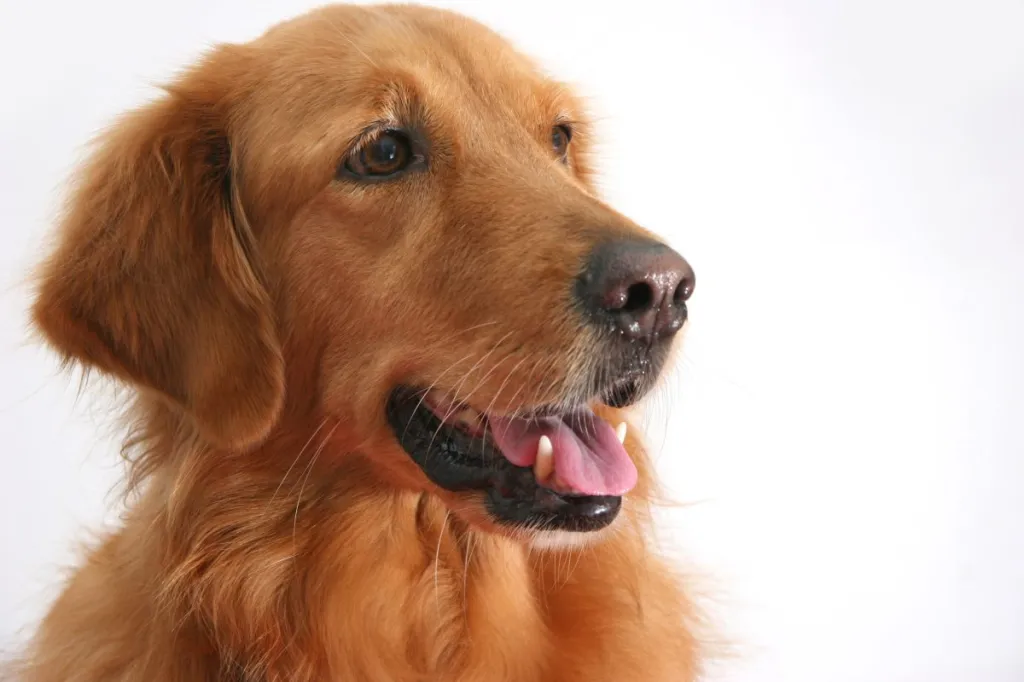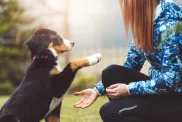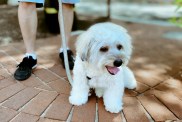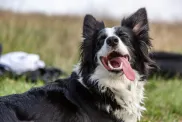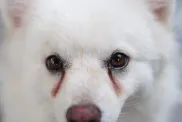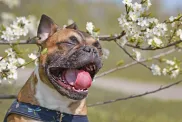The Golden Retriever is one of the most popular dog breeds in the United States. The breed’s friendly attitude makes them great family pets, and their intelligence makes them highly capable working dogs.
Their high level of cognitive ability allows them to quickly learn various tasks. This makes them ideal candidates for training, assistance work, and therapy roles. They exhibit excellent problem-solving skills, can follow complex commands, and excel in obedience training. Beyond their inherent intelligence, Golden Retrievers are extremely emotionally intelligent, displaying a keen sense of empathy and understanding. This combination of cognitive and emotional intelligence contributes to their versatility and adaptability.
Golden Retrievers excel at retrieving game, tracking, and as therapy and service dogs. In addition, they’re natural athletes and do well in dog sports such as agility and competitive obedience.
Quick Facts
- Origin: Scotland
- Size: Large, typically weighing around 55-75 pounds (25-34 kg) for females and 65-75 pounds (29-34 kg) for males.
- Lifespan: 10-12 years
- Coat: Dense, water-repellent double coat that is usually golden in color. They can have different shades of gold, from pale to dark.
- Temperament: Golden Retrievers are friendly, intelligent, and devoted dogs. They are known for their gentle and patient nature, making them excellent family pets and service dogs.
- Exercise Needs: They have moderate to high exercise requirements. Regular walks, playtime, and mental stimulation are important for their well-being.
- Training: Golden Retrievers are highly trainable and eager to please. They excel in obedience and various activities like agility and therapy work.
- Grooming: Their coat requires regular brushing to prevent matting, especially during shedding seasons. They shed moderately year-round and more heavily during shedding periods.
- Health: Golden Retrievers can be prone to certain health issues, including hip and elbow dysplasia, cancer, and heart conditions. Regular veterinary care and a balanced diet are important for their overall health.
- The character “Buddy” from the film “Air Bud” was a Golden Retriever.
- Golden retrievers are known for their “soft mouth.” This means that they can carry objects in their mouths without biting or crushing them. This makes them ideal for retrieving game birds and other objects.
RELATED: Golden Retriever Puppies: Cute Pictures & Facts
Golden Retriever Pictures

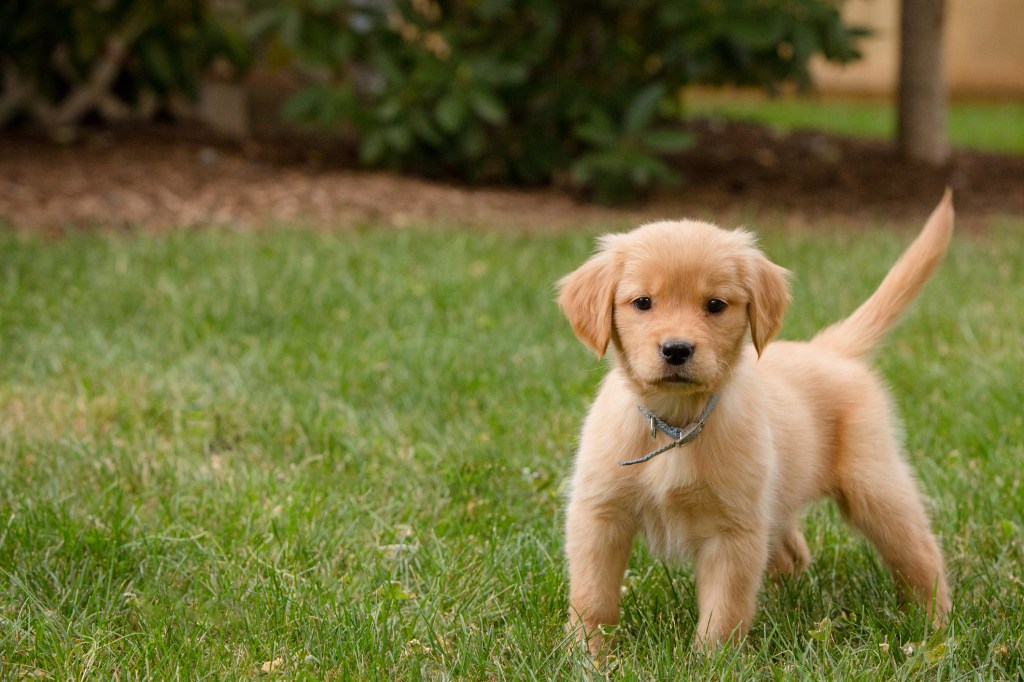
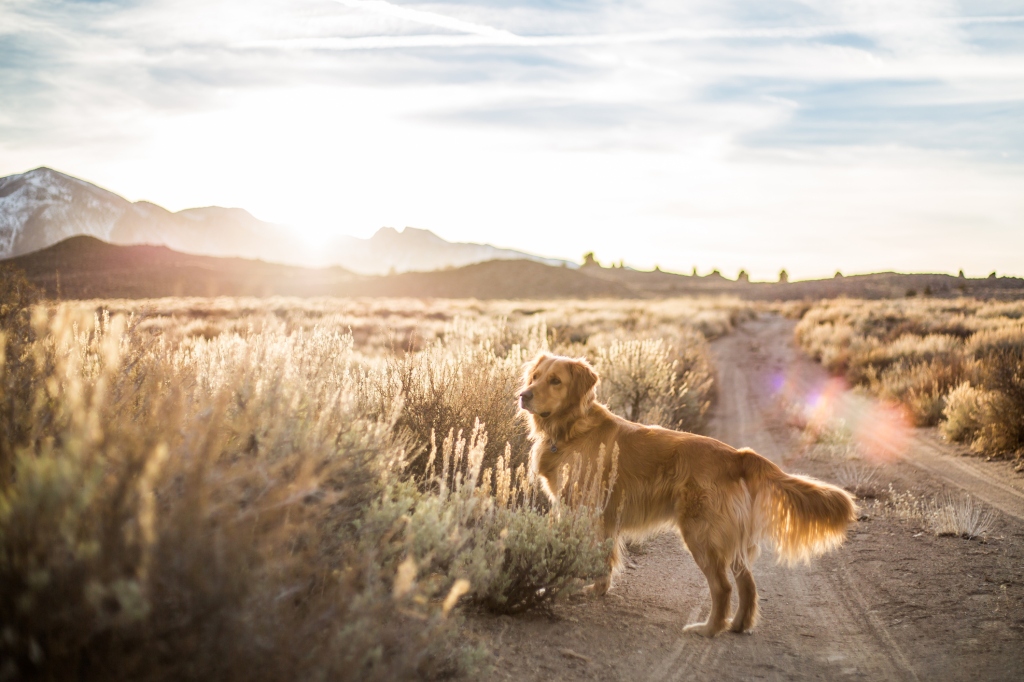
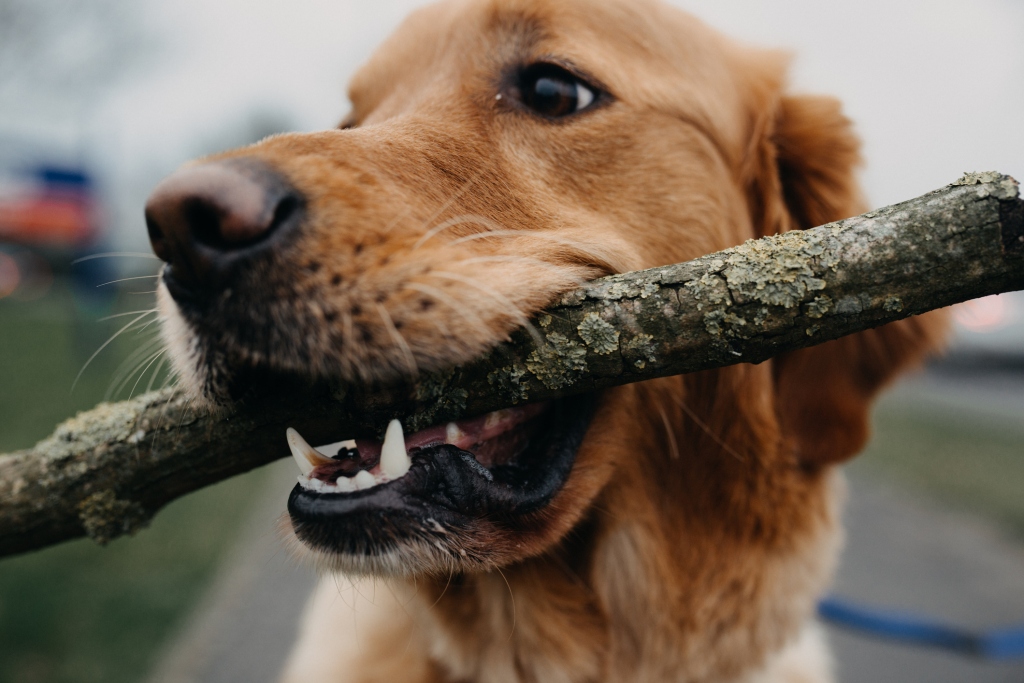
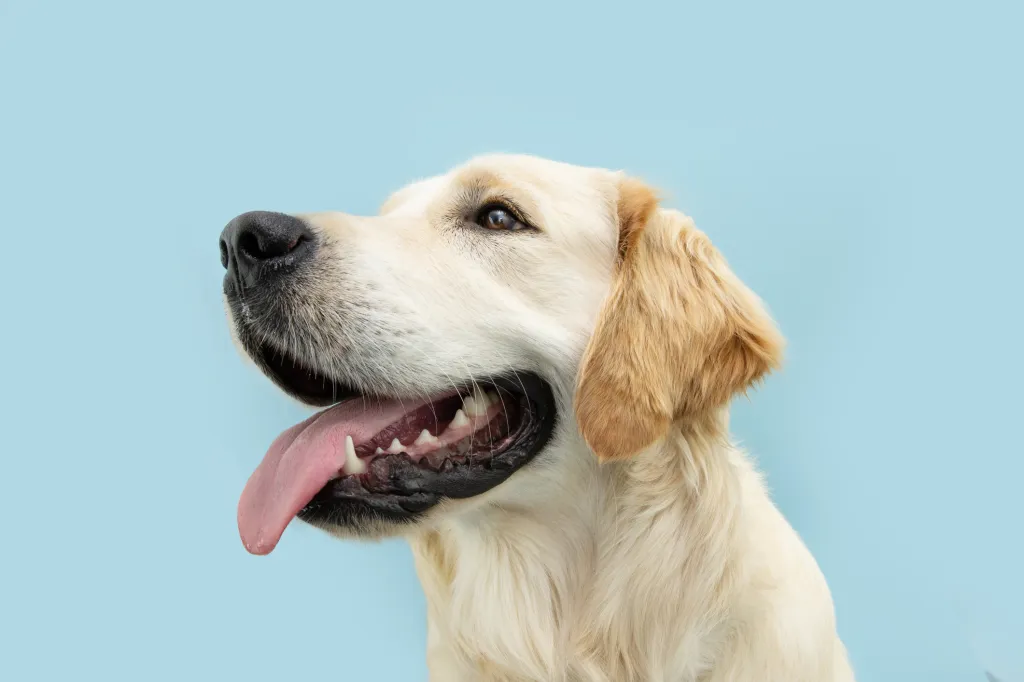
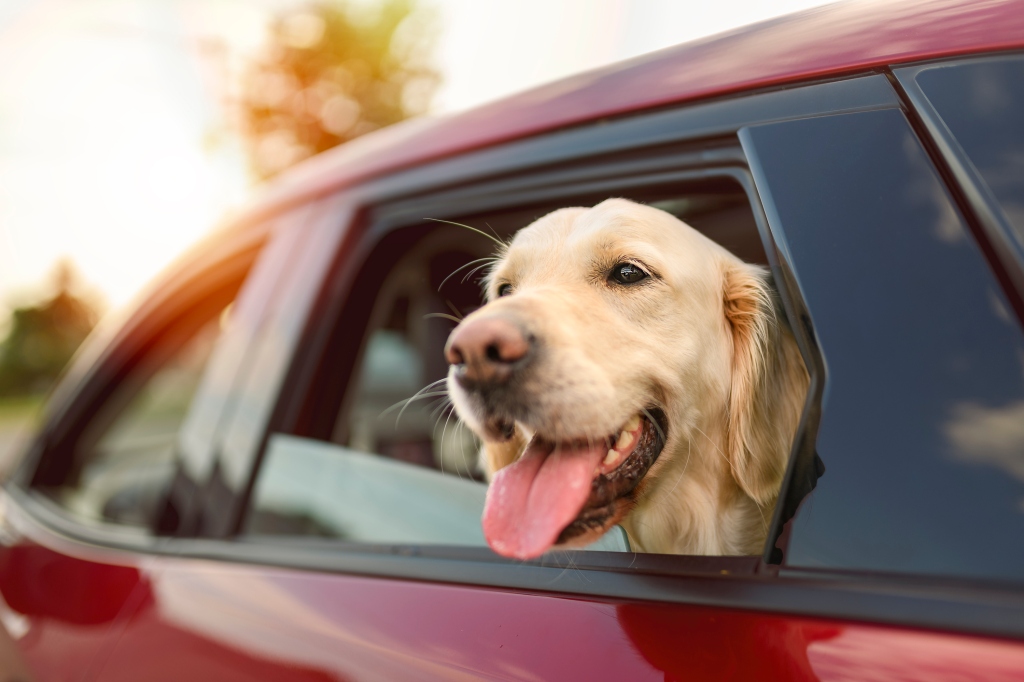
Adaptability
-
Adapts Well To Apartment Living
Looking for the best dog for your apartment? Contrary to popular belief, the suitability of dogs who adapt well to apartment living goes beyond its size. Apartment dwellers have a myriad of dog breeds to choose from as potential companions, with various factors to consider. Some large breeds can adapt well to apartment living and have lower activity levels. Others may require more space and possess higher energy levels. On the other hand, certain small dog breeds with abundant energy can still find contentment with indoor playtime or brisk walks.
However, when selecting a dog that adapts well apartments, it is essential to prioritize your neighbors. Opting for a pet that doesn’t excessively bark and behaves politely when encountering others in shared spaces like is crucial for maintaining a harmonious apartment environment.
In high-rise settings, it’s worth noting that numerous small dogs may exhibit a propensity for high energy and frequent barking. This makes them less suitable for apartment living. Therefore, desirable qualities in an apartment dog encompass being quiet, low-energy, and displaying polite behavior towards other residents.
Factors To Consider When Choosing A Dog For An Apartment
When considering dogs that adapt well to apartments, size alone should not be the sole determinant. Apartment dwellers have a wealth of dog breeds to choose from as potential furry companions. It’s important to remember that the size of your living space is just one factor to consider. While some larger breeds can adapt well to apartment living, with lower, others may require more space and have higher energy levels, making them less suitable for smaller apartments. Conversely, certain small dog breeds with higher energy levels can still thrive in apartments, finding contentment through indoor playtime or brisk walks. However, it is crucial to consider your neighbors’ comfort when selecting a dog. Opt for a pet that doesn’t bark excessively and behaves politely when interacting with others in shared spaces.
Therefore, it’s important to prioritize qualities such as being quiet, low-energy, calm indoors, and exhibiting good manners when living in close proximity to other residents. By considering these factors, you can find a dog that will adapt well to apartment living and create a harmonious living environment for everyone involved.
-
Good For Novice Owners
Some dogs are simply easier than others; they take to training better and are fairly easygoing. They’re also resilient enough to bounce back from your mistakes or inconsistencies.
Dogs who are highly sensitive, independent thinking, or assertive may be harder for a first-time dog parent to manage. You’ll get your best match if you take your dog-owning experience into account as you choose your new pooch.
If you’re new to dog parenting, take a look at 101 Dog Tricks and read up on how to train your dog!
-
Sensitivity Level
Some dogs will let a stern reprimand roll off their backs, while others take even a dirty look to heart. Low-sensitivity dogs, also called “easygoing,” “tolerant,” “resilient,” and even “thick-skinned,” can better handle a noisy, chaotic household, a louder or more assertive owner, and an inconsistent or variable routine. Do you have young kids, throw lots of dinner parties, play in a garage band, or lead a hectic life? Go with a low-sensitivity dog.
-
Tolerates Being Alone
Some breeds bond very closely with their family and are more prone to worry or even panic when left alone by their owner. An anxious dog can be very destructive–barking, whining, chewing, and otherwise causing mayhem. These breeds do best when a family member is home during the day or if you can take the dog to work.
-
Tolerates Cold Weather
Breeds with very short coats and little or no undercoat or body fat, such as Greyhounds, are vulnerable to the cold. Dogs with a low cold tolerance need to live inside in cool climates and should have a jacket or sweater for chilly walks. You can find a great jacket for your dog here!
-
Tolerates Hot Weather
Dogs with thick, double coats are more vulnerable to overheating. So are breeds with short noses, like Bulldogs or Pugs, since they can’t pant as well to cool themselves off. If you want a heat-sensitive breed, your dog will need to stay indoors with you on warm or humid days, and you’ll need to be extra cautious about exercising your dog in the heat.
All-around friendliness
-
Affectionate With Family
When it comes to unconditional love and unwavering loyalty, few animals can rival the affectionate nature of dogs. These remarkable creatures have earned their reputation as man’s best friend, and many breeds are particularly renowned for their love and devotion to their families. With their warm hearts and wagging tails, affectionate family dogs enrich the lives of their owners in countless ways.
One such breed known for its affectionate demeanor is the Golden Retriever. With their gentle temperament and friendly disposition, Golden Retrievers form deep bonds with their families. They eagerly participate in family activities, whether it’s a game of fetch in the yard or cuddling on the couch during a movie night. Their expressive eyes and ever-wagging tails are a testament to the joy they feel in the presence of their loved ones.
Another family-favorite breed is the Labrador Retriever. Renowned for their playful and patient nature, Labradors are excellent companions for children and adults alike. They readily engage in playtime with the kids, showcasing their boundless energy and enthusiasm. But when the day winds down, they seamlessly transition into loving and gentle cuddle buddies, comforting their family members with their warm presence.
Beyond specific breeds, mixed-breed dogs also have a special place in the hearts of families seeking affectionate companions. The shelter dogs, in particular, form deep connections with their adoptive families. They seem to understand the second chance they’ve been given and repay it with endless love and gratitude.
How To Know If A Dog Is Good With Families
The affectionate nature of family dogs extends beyond play and cuddles. Dogs have a remarkable ability to sense their owner’s emotions, offering comfort and support during difficult times. Whether it’s a wagging tail after a long day at work or a sympathetic nuzzle during moments of sadness, they prove time and again that they are attuned to their family’s needs.
It is important to note that not all dogs of the same breed will be equally affectionate. Some dogs may be more independent or aloof, while others may be more clingy or demanding of attention. The best way to find out how affectionate a dog is is to meet them in person and interact with them.
-
Kid-Friendly
Being gentle with children, sturdy enough to handle the heavy-handed pets and hugs they can dish out, and having a blasé attitude toward running, screaming children are all traits that make a kid-friendly dog. You may be surprised by who’s on that list: Fierce-looking Boxers are considered good with children, as are American Staffordshire Terriers (which are considered Pit Bulls). Small, delicate, and potentially snappy dogs such as Chihuahuas aren’t always so family-friendly.
**All dogs are individuals. Our ratings are generalizations, and they’re not a guarantee of how any breed or individual dog will behave. Dogs from any breed can be good with children based on their past experiences, training on how to get along with kids, and personality. No matter what the breed or breed type, all dogs have strong jaws, sharp pointy teeth, and may bite in stressful circumstances. Young children and dogs of any breed should always be supervised by an adult and never left alone together, period.
-
Dog Friendly
Friendliness toward dogs and friendliness toward humans are two completely different things. Some dogs may attack or try to dominate other dogs, even if they’re love-bugs with people; others would rather play than fight; and some will turn tail and run. Breed isn’t the only factor. Dogs who lived with their littermates and mother until at least six to eight weeks of age and who spent lots of time playing with other dogs during puppyhood, are more likely to have good canine social skills.
-
Friendly Toward Strangers
Stranger-friendly dogs will greet guests with wagging tails and nuzzles; others are shy, indifferent, or even aggressive. However, no matter what the breed, a dog who was socialized and exposed to lots of different types, ages, sizes, and shapes of people as a puppy will respond better to strangers as an adult. Remember that even friendly dogs should stay on a good, strong leash like this one in public!
Health And Grooming Needs
-
Amount Of Shedding
If you’re going to share your home with a dog, you’ll need to deal with some level of dog hair on your clothes and in your house. However, shedding does vary greatly among the breeds. Some dogs shed year-round, some “blow” seasonally, some do both, and some shed hardly at all. If you’re a neatnik, you’ll need to either pick a low-shedding breed or relax your standards. To help keep your home a little cleaner, you can find a great de-shedding tool here!
-
Drooling Potential
Drool-prone dogs may drape ropes of slobber on your arm and leave big, wet spots on your clothes when they come over to say hello. If you’ve got a laid-back attitude toward slobber, fine; but if you’re a neatnik, you may want to choose a dog who rates low in the drool department.
-
Easy To Groom
Some breeds are brush-and-go dogs; others require regular bathing, clipping, and other grooming just to stay clean and healthy. Consider whether you have the time and patience for a dog who needs a lot of grooming, or the money to pay someone else to do it.
-
General Health
Due to poor breeding practices, some breeds are prone to certain genetic health problems, such as hip dysplasia. This doesn’t mean that every dog of that breed will develop those diseases; it just means that they’re at an increased risk.
If you’re adopting a puppy, it’s a good idea to find out which genetic illnesses are common to the breed you’re interested in. You may also want to ask if your shelter or rescue has information about the physical health of your potential pup’s parents and other relatives.
-
Potential For Weight Gain
Some breeds have hearty appetites and tend to put on weight easily. As in humans, being overweight can cause health problems in dogs. If you pick a breed that’s prone to packing on pounds, you’ll need to limit treats, make sure they get enough exercise, and measure out their daily food servings into regular meals rather than leaving food out all the time.
Ask your vet about your dog’s diet and what they recommend for feeding your pooch to keep them at a healthy weight. Weight gain can lead to other health issues or worsen problems like arthritis.
-
Size
Get ready to meet the giants of the doggy world! Large dog breeds aren’t just big balls of fluff, they’re like loving, oversized teddy bears on a mission to steal your heart. Need some convincing? Let’s dive into the awesome benefits of owning one!
First things first, these pooches are a living security system! With their impressive size and thunderous barks, they’ll have any would-be intruder running for the hills. Talk about peace of mind! Plus, who needs an alarm when you’ve got a furry giant protecting your castle?
But that’s not all. Large dog breeds are all about loyalty and devotion. They’ll stick by your side through thick and thin, becoming your most dedicated bestie. Their love knows no bounds! When you have a giant fluffball showing you unconditional love, you’ll feel like the luckiest human on the planet.
Now, let’s talk about their talents. These big fellas are the ultimate working partners. With brains and brawn, they’re up for any challenge. From search and rescue missions to lending a helping paw to those in need, these dogs are superheroes in fur coats. They’ll make you proud every step of the way!
Don’t let their size fool you—these gentle giants have hearts as big as their paws. They’re incredible with kids and other pets, spreading their love like confetti. Their patience and kindness make them perfect family pets, ensuring harmony in your household.
Oh, and get ready to break a sweat! These dogs are fitness enthusiasts, and they’ll keep you on your toes. Daily walks, jogs, and play sessions will not only keep them happy and healthy but will also give you a reason to ditch the couch and join in on the fun. It’s a win-win situation!
So, if you’re ready for a dose of big love, go ahead and consider a large dog breed. They’re the best wing-dog you could ever ask for, ready to make your life a thousand times more exciting, loving, and downright awesome! Get ready for the big adventure of a lifetime!
Trainability
-
Easy To Train
Easy-to-train dogs are more adept at forming an association between a prompt (such as the word “sit”), an action (sitting), and a consequence (getting a treat) very quickly. Other dogs need more time, patience, and repetition during training.
Many breeds are intelligent but approach training with a “What’s in it for me?” attitude, in which case you’ll need to use rewards and games to teach them to want to comply with your requests.
Related:
10 Fun, Impressive Tricks You Can Teach Any Dog
-
Intelligence
Dogs who were bred for jobs that require decision making, intelligence, and concentration, such as herding livestock, need to exercise their brains, just as dogs who were bred to run all day need to exercise their bodies. If they don’t get the mental stimulation they need, they’ll make their own work–usually with projects you won’t like, such as digging and chewing. Obedience training and interactive dog toys are good ways to give a dog a brain workout, as are dog sports and careers, such as agility and search and rescue.
-
Potential For Mouthiness
Common in most breeds during puppyhood and in Retriever breeds at all ages, mouthiness means a tendency to nip, chew, and play-bite (a soft, fairly painless bite that doesn’t puncture the skin). Mouthy dogs are more likely to use their mouths to hold or “herd” their human family members, and they need training to learn that it’s fine to gnaw on chew toys, but not on people. Mouthy breeds tend to really enjoy a game of fetch, as well as a good chew on a toy that’s been stuffed with kibble and treats.
-
Prey Drive
Dogs with a high prey drive have an instinctive desire to stalk, capture, and prey upon potential food sources. Dogs who were bred to hunt, such as Terriers, have an inborn desire to chase — and sometimes kill — other animals. Anything whizzing by — such as cats, squirrels, and perhaps even cars — can trigger that instinct.
How to address a high prey drive
Off-leash adventures are too great a temptation for pups who will wander and hunt. Dogs who like to chase need to be leashed. And, even on a leash, you may experience your dog pulling on the leash to reach rodents or birds in their sight. Otherwise, these pups should be kept in a fenced area when outdoors. If your pup has a high prey drive, you’ll need a high, secure fence in your yard.
These breeds generally aren’t a good fit for homes with smaller pets that can look like prey, such as cats, hamsters, or small dogs. Breeds that were originally used for bird hunting, on the other hand, generally won’t chase, but you’ll probably have a hard time getting their attention when there are birds flying by.
Other behavioral concerns
Observing your dog’s prey drive, which is instinctual and biologically-rooted, is not the same as observing aggression. Much aggression is born of fear and anxiety, especially in the case of dog aggression toward humans.
The tendency to wander, even into oncoming traffic, can produce diasterious results for pups with predatory instincts. It can also lead to pups being bitten by snakes or attacked by other wild animals they may pursue while on the hunt.
-
Tendency To Bark Or Howl
Some breeds sound off more often than others. When choosing a breed, think about how often the dog vocalizes. Learn more about breeds with a tendency to bark or howl.
If you’re considering a hound, would you find their trademark howls musical or maddening? If you’re considering a watchdog, will a city full of suspicious “strangers” put your pup on permanent alert? Will the local wildlife literally drive your dog wild? Do you live in housing with noise restrictions? Do you have neighbors nearby? Then you may wish to choose a quieter dog.
-
Wanderlust Potential
Some breeds are more free-spirited than others. Nordic dogs such as Siberian Huskies were bred to range long distances, and given the chance, they’ll take off after anything that catches their interest. And many hounds simply must follow their noses–or that bunny that just ran across the path–even if it means leaving you behind.
Exercise needs
-
Energy Level
High-energy dogs are always ready and waiting for action. Originally bred to perform a canine job of some sort, such as retrieving game for hunters or herding livestock, they have the stamina to put in a full workday. They need a significant amount of exercise and mental stimulation, and they’re more likely to spend time jumping, playing, and investigating any new sights and smells.
Low-energy dogs are the canine equivalent of a couch potato, content to doze the day away. When picking a breed, consider your own activity level and lifestyle, and think about whether you’ll find a frisky, energetic dog invigorating or annoying.
-
Intensity
A vigorous dog may or may not have high energy, but everything they do, they do with vigor: they strain on the leash (until you train them not to), try to plow through obstacles, and even eats and drinks with great big gulps. These dynamos need lots of training to learn good manners, and may not be the best fit for a home with young kids or someone who’s elderly or frail. A low-vigor dog, on the other hand, has a more subdued approach to life.
-
Exercise Needs
Some breeds do fine with a slow evening stroll around the block. Others need daily, vigorous exercise, especially those that were originally bred for physically demanding jobs, like herding or hunting.
Without enough exercise, these breeds may put on weight and vent their pent-up energy in ways you don’t like, such as barking, chewing, and digging. Breeds that need a lot of exercise are good for outdoorsy, active people, or those interested in training their dog to compete in a high-energy dog sport, such as agility.
-
Potential For Playfulness
Some dogs are perpetual puppies — always begging for a game — while others are more serious and sedate. Although a playful pup sounds endearing, consider how many games of fetch or tag you want to play each day, and whether you have kids or other dogs who can stand in as playmates for the dog.
Golden Retriever Overview
It’s no surprise that the Golden Retriever is one of the top ten most popular dogs in the U.S. It’s all good with the Golden: he’s highly intelligent, sociable, beautiful, and loyal. He’s also lively. The Golden is slow to mature and retains the silly, playful personality of a puppy until three to four years of age, which can be both delightful and annoying. Many keep their puppyish traits into old age.
Originally bred for the physically demanding job of retrieving ducks and other fowl for hunters, the Golden needs daily exercise: a walk or jog, free time in the yard, a run at the beach or lake (Goldens love water), or a game of fetch. And like other intelligent breeds who were bred to work, they need to have a job to do, such as retrieving the paper, waking up family members, or competing in dog sports. A tired Golden is a well-behaved Golden.
As well as giving your Golden Retriever physical and mental exercise, you should also be prepared to include him in your family activities. The Golden Retriever is a family dog, and he needs to be with his “pack.” Don’t consider getting a Golden unless you’re willing to have him in the house with you, underfoot, every day. There’s one other potential drawback to the breed: He’s definitely not a watchdog. He might bark when strangers come around, but don’t count on it. Most likely, he’ll wag his tail and flash that characteristic Golden smile.
Golden Retriever Highlights
Golden Retrievers shed a lot, especially during spring and fall. Brushing their coat daily helps remove loose hair, preventing it from spreading on your clothes and around your home. Living with a Golden means embracing their shedding.
These dogs are part of the family and thrive indoors with their human “pack.” Leaving them alone in the backyard for extended periods isn’t ideal.
Golden Retrievers are active and require 40-60 minutes of vigorous exercise every day. They enjoy obedience training, agility classes, and other dog activities that provide both physical and mental stimulation.
While they are gentle and reliable around children, Golden Retrievers are large and exuberant, which might accidentally knock over small kids.
Goldens have hearty appetites and can become overweight if overfed. Manage treats, measure their daily food portions, and feed them regular meals instead of leaving food out all day.
Due to their popularity, some breeders prioritize profit over the well-being of the dogs. To ensure a healthy pup, avoid irresponsible breeders, puppy mills, or pet stores. Look for reputable breeders who test their breeding dogs for genetic diseases and focus on good temperaments.
Golden Retriever History
For many years, there was a legend that Golden Retrievers were descended from Russian sheepdogs bought from a circus. In fact, the breed was developed in Scotland, at the highland estate of Sir Dudley Majoribanks, later known as Lord Tweedmouth. Tweedmouth, like many gentry of his day, bred animals of all kinds, trying to perfect different breeds.
Tweedmouth’s breeding records from 1835 to 1890 show what he was aiming for with the Golden: A talented retriever — Tweedmouth was an ardent waterfowl hunter — with a superb nose, who would be more attentive to his human hunting companion than the setters and spaniels used at the time for retrieving. He also wanted the dog to be loyal and even-tempered in the home. Tweedmouth took Nous home to Scotland, and in 1868 and 1871, bred him to Belle, a Tweed Water Spaniel.
Tweed Water Spaniels (now extinct) were known for being eager retrievers in the hunting field, and exceptionally calm and loyal in the home — characteristics you’ll find in today’s Golden Retrievers. Nousand Belle’s descendants were bred with Wavy- and Flat-coated retrievers, another Tweed Water Spaniel, and a red setter.
Tweedmouth kept mostly the yellow puppies to continue his breeding program, and gave others away to friends and relatives. Not surprisingly, Tweedmouth’s breed first attracted attention for their skills in the hunting field. One of the most well-known was Don of Gerwyn, a liver-coated descendent of one of Tweedmouth’s dogs, who won the International Gundog League trial in 1904. The Kennel Club in England officially recognized the Golden Retriever as a distinct breed in 1911. At that time, they were classified as “Retriever — Yellow or Golden.” In 1920, the breed name was officially changed to Golden Retriever. The American Kennel Club recognized the breed in 1932. Today, the Golden Retriever is the second most popular breed in the U.S.
Golden Retriever Size
Males are 23 to 24 inches tall and weigh 65 to 75 pounds. Females are generally 21.5 to 22.5 inches tall and 55 to 65 pounds. Golden Retrievers usually reach their full height by one year of age, and their mature weight by two.
Golden Retriever Personality
A sweet, calm nature is the hallmark of the breed. The Golden was bred to work with people, and is eager to please his owner. Though hard-wired with a good disposition, like all dogs the Golden must be well-raised and well-trained to make the most of his heritage.
Like every dog, the Golden needs early socialization — exposure to many different people, sights, sounds, and experiences — when they’re young. Socialization helps ensure that your Golden puppy grows up to be a well-rounded dog.
Golden Retriever Health
Goldens are generally healthy, but like all breeds, they’re prone to certain health conditions. Not all Goldens will get any or all of these diseases, but it’s important to be aware of them if you’re considering this breed. If you’re buying a puppy, find a good breeder who will show you health clearances for both your puppy’s parents. Health clearances prove that a dog has been tested for and cleared of a particular condition. In Goldens, you should expect to see health clearances from the Orthopedic Foundation for Animals (OFA) for hip dysplasia (with a score of fair or better), elbow dysplasia, hypothyroidism, and von Willebrand’s disease; from Auburn University for thrombopathia; and from the Canine Eye Registry Foundation (CERF) certifying that eyes are normal. You can confirm health clearances by checking the OFA web site (offa.org).
- Hip Dysplasia: Hip dyplasia is a heritable condition in which the thighbone doesn’t fit snugly into the hip joint. Some dogs show pain and lameness on one or both rear legs, but you may not notice any signs of discomfort in a dog with hip dysplasia. As the dog ages, arthritis can develop. X-ray screening for hip dysplasia is done by the Orthopedic Foundation for Animals or the University of Pennsylvania Hip Improvement Program. Dogs with hip dysplasia should not be bred. If you’re buying a puppy, ask the breeder for proof that the parents have been tested for hip dysplasia and are free of problems.
- Elbow Dysplasia: This is a heritable condition common to large-breed dogs. It’s thought to be caused by different growth rates of the three bones that make up the dog’s elbow, causing joint laxity. This can lead to painful lameness. Your vet may recommend surgery to correct the problem or medication to control the pain.
- Cataracts: As in humans, canine cataracts are characterized by cloudy spots on the eye lens that can grow over time. They may develop at any age, and often don’t impair vision, although some cases cause severe vision loss. Breeding dogs should be examined by a board-certified veterinary ophthamologist to be certified as free of hereditary eye disease before they’re bred. Cataracts can usually be surgically removed with good results.
- Progressive Retinal Atrophy (PRA): PRA is a family of eye diseases that involves the gradual deterioration of the retina. Early in the disease, dogs become night-blind. As the disease progresses, they lose their daytime vision as well. Many dogs adapt to limited or complete vision loss very well, as long as their surroundings remain the same.
- Subvalvular Aortic Stenosis: This heart problem is caused by a narrow connection between the left ventricle (out-flow) and the aorta. It can cause fainting and even sudden death. Your vet can detect it and prescribe the proper treatment.
- Osteochondrosis Dissecans (OCD): This orthopedic condition, caused by improper growth of cartilage in the joints, usually occurs in the elbows, but it has been seen in the shoulders as well. It causes a painful stiffening of the joint, to the point that the dog is unable to bend his elbow. It can be detected in dogs as early as four to nine months of age. Overfeeding of “growth formula” puppy foods or high-protein foods may contribute to its development.
- Allergies: Golden Retrievers can be allergic to a variety of substances, ranging from food to pollen. If your Golden is licking his paws or rubbing his face a great deal, have him checked by your vet.
- Von Willebrand’s Disease: This is an inherited blood disorder that interferes with the blood’s ability to clot. The main symptom is excessive bleeding after an injury or surgery. Other symptoms include nosebleeds, bleeding gums, or bleeding in the stomach or intestines. There is no cure, and a blood transfusion from the blood of normal dogs is currently the only treatment. Research is underway for new treatments, including medication. Most dogs with von Willebrand’s disease can lead normal lives. A vet can test your dog for the condition. Dogs with this condition should not be bred.
- Gastric Dilatation-Volvulus: Commonly called bloat, this is a life-threatening condition that affects large, deep-chested dogs like Golden Retrievers, especially if they’re fed one large meal a day, eat rapidly, or drink large amounts of water or exercise vigorously after eating. Bloat occurs when the stomach is distended with gas or air and then twists. The dog is unable to belch or vomit to rid himself of the excess air in his stomach, and blood flow to the heart is impeded. Blood pressure drops and the dog goes into shock. Without immediate medical attention, the dog can die. Suspect bloat if your dog has a distended abdomen, is drooling excessively, and retching without throwing up. He also may be restless, depressed, lethargic, and weak with a rapid heart rate. If you notice these symptoms, get your dog to the vet as soon as possible.
- Epilepsy: Epilepsy is a brain disorder that causes periodic seizures and convulsions. Your vet will need to know how severe the seizures are and how often they occur to determine what medication to prescribe, if any.
- Hypothyroidism: This is a disorder of the thyroid gland that’s thought to cause conditions such as epilepsy, hair loss, obesity, lethargy, dark patches on the skin, and other skin conditions. It’s treated with medication and diet.
- Hemangiosarcoma: This is a very dangerous form of cancer that originates in the lining of blood vessels and spleen. It most commonly occurs in middle-age and elderly dogs.
- Osteosarcoma: Osteosarcoma is a malignant bone cancer that’s common in large and giant breeds.
Golden Retriever Care
Golden Retrievers are built for action and love outdoor romps. If you like to hike or jog, your Golden will be happy to join you. And if you feel like tossing a ball in the backyard, they’d be more than happy to join you; true to their name, Goldens love to retrieve. Tiring them out with 20-30 minutes of vigorous exercise twice a day will keep your dog mellow when he’s back inside. Slacking on the activity, however, could lead to behavior problems.
Like other retriever breeds, Goldens are naturally “mouthy,” and they’re happiest when they have something to carry in their mouths: a ball, soft toy, newspaper, or best of all, a smelly sock. You’ll need to take special care if you’re raising a Golden puppy. These dogs grow very rapidly between the age of four and seven months, making them susceptible to bone disorders. Don’t let your Golden puppy run and play on very hard surfaces such as pavement until he’s at least two years old and his joints are fully formed. Normal play on grass is fine, and so are puppy agility classes.
Golden Retriever Feeding
Recommended daily amount: 2 to 3 cups of high-quality dry food a day, divided into two meals. NOTE: How much your adult dog eats depends on his size, age, build, metabolism, and activity level. Dogs are individuals, just like people, and they don’t all need the same amount of food. It almost goes without saying that a highly active dog will need more than a couch potato dog. The quality of dog food you buy also makes a difference — the better the dog food, the further it will go toward nourishing your dog and the less of it you’ll need to shake into your dog’s bowl.
Keep your Golden in good shape by measuring his food and feeding him twice a day rather than leaving food out all the time. If you’re unsure whether he’s overweight, give him the eye test and the hands-on test. First, look down at him. You should be able to see a waist. Then place your hands on his back, thumbs along the spine, with the fingers spread downward. You should be able to feel but not see his ribs without having to press hard.
If you can’t, he needs less food and more exercise. You’ll need to take special care if you’re raising a Golden puppy. These dogs grow very rapidly between the age of four and seven months, making them susceptible to bone disorders. They do well on a high-quality, low-calorie diet that keeps them from growing too fast. For more on feeding your Golden, see our guidelines for buying the right food, feeding your puppy, and feeding your adult dog.
Golden Retriever Coat Color And Grooming
Golden Retrievers have a dense, water-repellent outer coat with a thick undercoat. Some coats are wavy, some are straight. The fur feathers on the back of the front legs and underbody, with heavier feathering on the chest, back of the thighs, and tail. Golden Retrievers come in all shades of gold, from light to dark gold.
Some breeders have begun selling “rare white Goldens,” but the American Kennel Club does not recognize white as a coat color for the breed. Golden Retrievers shed moderately in the winter and summer, and heavily in the spring and fall. If you live with a Golden, you’ll need to adapt to a certain amount of dog hair in your house and on your clothes. The Golden’s thick coat means lots of grooming. Daily brushing is recommended to prevent tangling, and once a week is the bare minimum. Your Golden will also need a bath at least once a month, often more frequently, to keep him looking and smelling clean.
Brush your Golden’s teeth at least two or three times a week to remove tartar buildup and the bacteria that lurk inside it. Daily brushing is even better if you want to prevent gum disease and bad breath. Trim nails once or twice a month if your dog doesn’t wear them down naturally. If you can hear them clicking on the floor, they’re too long.
Short, neatly trimmed nails keep the feet in good condition. Dog toenails have blood vessels in them, and if you cut too far you can cause bleeding — and your dog may not cooperate the next time he sees the nail clippers come out. So, if you’re not experienced trimming dog nails, ask a vet or groomer for pointers. Fold-over ears create a warm, dark environment for bacteria or fungus to grow in, and breeds that have them — such as the Golden — are prone to ear infections. His ears should be checked weekly for redness or a bad odor, which can indicate an infection. Check them every time he gets wet, too.
When you check your dog’s ears, wipe them out with a cotton ball dampened with gentle, pH-balanced ear cleaner to help prevent infections. Don’t insert anything into the ear canal; just clean the outer ear. Begin accustoming your Golden to being brushed and examined when he’s a puppy. Handle his paws frequently — dogs are touchy about their feet — and look inside his mouth. Make grooming a positive experience filled with praise and rewards, and you’ll lay the groundwork for easy veterinary exams and other handling when he’s an adult. As you groom, check for sores, rashes, or signs of infection such as redness, tenderness, or inflammation on the skin, in the nose, mouth, and eyes, and on the feet. Eyes should be clear, with no redness or discharge. Your careful weekly exam will help you spot potential health problems early.
Golden Retriever Children And Other Pets
The amiable Golden Retriever isn’t bothered by the noise and commotion of kids — in fact, he thrives on it. He’s a large, strong dog, though, and he can easily knock over a small child by mistake. As with every breed, you should always teach children how to approach and touch dogs, and always supervise any interactions between dogs and young children to prevent any biting or ear or tail pulling on the part of either party.
Teach your child never to approach any dog while he’s eating or sleeping or to try to take the dog’s food away. No dog, no matter how friendly, should ever be left unsupervised with a child. The Golden’s attitude toward other pets is the more the merrier. He enjoys the companionship of other dogs, and with proper introductions and training, can be trusted with cats, rabbits, and other animals.
Golden Retriever Rescue Groups
Goldens are often purchased without any clear understanding of what goes into owning one. There are many Goldens in need of adoption and or fostering. There are a number of rescues that we have not listed. If you don’t see a rescue listed for your area, contact the national breed club or a local breed club and they can point you toward a Golden rescue.
Golden Retriever Breed Organizations
Finding a reputable dog breeder is one of the most important decisions you will make when bringing a new dog into your life. Reputable breeders are committed to breeding healthy, well-socialized puppies that will make great companions. They will screen their breeding stock for health problems, socialize their puppies from a young age, and provide you with lifetime support.
On the other hand, backyard breeders are more interested in making a profit than in producing healthy, well-adjusted dogs. They may not screen their breeding stock for health problems, and they may not socialize their puppies properly. As a result, puppies from backyard breeders are more likely to have both health and behavioral issues.
